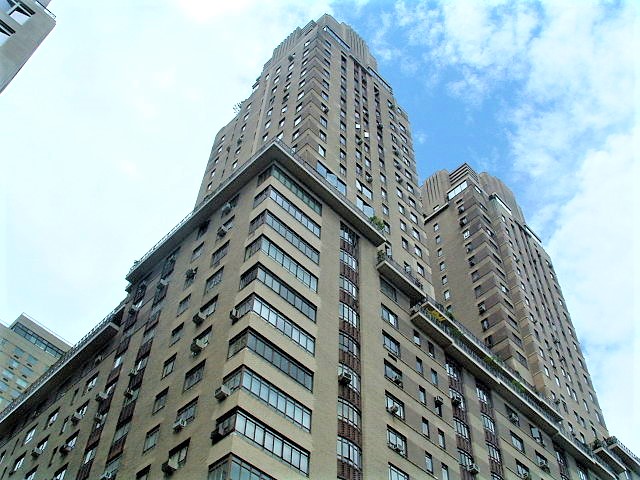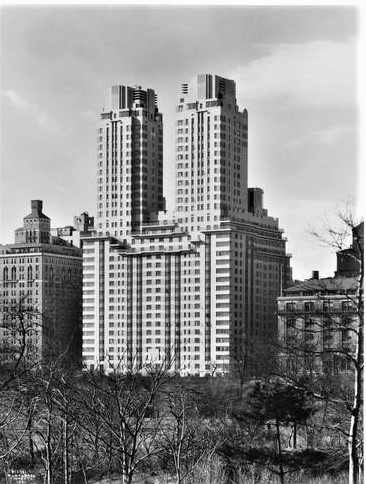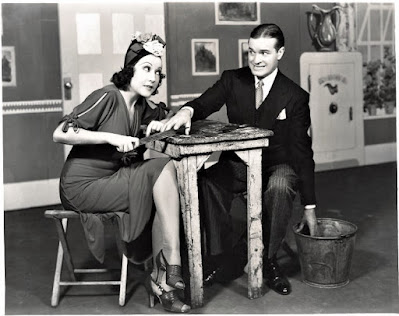photo by Fbv65edel
The massive 1909 Century Theatre (originally the New Theatre) was sold by the Shubert Brothers in 1929 to the Chanin Construction Co., headed by architect/developer Irwin Salmon Chanin. In fact, on May 28 the Chanin firm announced its intentions to purchase the entire block from 62nd to 63rd, and from Central Park West to Broadway.
Originally, Irwin Chanin announced that his Palais de France would occupy the site--a multi-use building that would include exhibition space, French-based stores, offices of the French consulate, a hotel, and additional office space for French firms. Chanin traveled to France to negotiate the sale of the site to the Government, but things fizzled. Instead of the ambitious Palaise de France, Chanin's focus turned to a modern high-rise apartment building.
At the time, Chanin's Art Deco style Hotel Majestic was rising ten blocks north on Central Park West. Like that building, the Century Apartments (named in honor of the theater), would mark the Central Park West skyline with twin towers. The 30-story structure brought welcomed jobs to the Depression-crippled construction industry. On June 21, 1931 The New York Times reported, "At one stage in the steel construction thirty trades were employed simultaneously. The number of men at work has been 1,050, and at one time there were 1,400 workers."
Chanin stressed vertical and horizonal planes in his Art Deco, or "modern American," design. The completed building held 417 apartments, many with Hollywood-set-ready sunken living rooms and fireplaces. Residents had views of Central Park or the landscaped private garden within the U-shaped building.
Irwin S. Chanin was undoubtedly pleased with his latest project, since he and his family were among the initial residents.
An advertisement in The Princeton Alumni Weekly was entitled, "The Century Has Everything and Central Park." It touted that the apartments included "such 'Century Specialties' as 3-room duplexes, 2-room and 4-room tower units with 3 exposures, 6-room tower suites with 4 exposures and 7-room corner solarium units facing the Park." (Those "solarium units" featured imported glass from England that permitted ultra-violet rays to penetrate the interiors.)
Along with the expected bankers and businessmen, the Century Apartments quickly attracted residents from the entertainment industry. On March 9, 1934 The Sun reported that actress Sally O'Neill had leased a duplex suite. Largely forgotten today, she was a film headliner, appearing in more than 40 films with co-stars like Constance Bennett and Joan Crawford.
Another entertainer in the building was Ethel Merman, whose career was skyrocketing. When she opened in Girl Crazy at the Alvin Theatre in 1930, The New Yorker deemed her "imitative of no one." Sharing her apartment were her parents, Edward and Agnes Zimmerman. (Ethel explained to The New York Sun, "Some people think I'm Jewish. I'm not. I'm Scotch-German. Mother is Scotch; father is German. And Merman was better for the stage than Zimmerman. So I dropped the Zim.")
Ethel Merman and Bob Hope on the set of Red, Hot and Blue. from the collection of the New York Public Library.
Ward Morehouse, The New York Sun's drama critic interviewed Ethel in her apartment shortly after midnight on November 6, 1936, following the opening of performance in Red, Hot and Blue. Agnes stayed up while he was there, possibly for propriety's sake. He wrote, "The living room was a flower shop; it had taken three cabs to haul her first-night tributes homeward."
The 28-year-old singer and actress had come a long way in a few years. Morehouse said, "It's my impression that when Mr. [Vinton] Freedley hired you for your first show, he paid you $350 weekly, but that you now get $3,500 a week."
In typical Merman fashion, she responded, "Something around that. It's a percentage arrangement. So far it's worked out all right. When Vinton told me he wanted me for Red, Hot and Blue I said sure, I'd like to work for him, but he'd have to pay me. Well, he did...We're giving a swell show right now." (Merman's Depression Era pay for Red, Hot and Blue would equal nearly $64,500 per week today.)
In 1937 Rose Gershwin, mother of George and Ira Gershwin, moved in. George had purchased a house on West 103rd Street for the family, but following his death that year the house was sold. Rose was the sold beneficiary of his estate. (She died at the age of 71 in her apartment on December 16, 1948.)
Other entertainment figures followed. On August 30, 1938 The New York Times announced, "Among those reported as having taken space in the thirty-story Century Apartments, 25 Central Park West, were Graham McNamee, radio announcer, and Al Goodman, orchestra leader. The former leased a terrace suite on the twelfth floor; the latter a seven-room solarium, facing Central Park." Al Goodman was one of the most sought-after conductors on Broadway, eventually directing over 150 first-night performances.
Film star Carmen Miranda took a duplex apartment in June 1939. And on the same day producer and stage manager Bernard Hart signed a lease for a duplex. Although Hart was overshadowed by his famous playwright brother, Moss Hart, he more than made a name for himself. Among the hit plays he would manage were My Fair Lady and Camelot.
Film sensation Carmen Miranda leased an apartment in 1939 after the filming of Banana da Terra. from the collection of the New York Public Library
Not everyone in the Century Apartments, of course, came from the entertainment field. In 1940 residents included F. Tirade, president of the Gulf Shipping Company of Mexico; Chester Gash, president of the A. Gash Olive Oil Company; and at least eight physicians.
That year author William March moved in. The former highly-decorated U.S. Marine was well-known for his parties. According to biographer Roy S. Simmonds in his 1984 The Two Worlds of William March:
It was here, in Apartment 30-K...that March gave the more flamboyant of his legendary cocktail parties. Findley McRae, one one occasion arriving early for a party, found in the refrigerator jugs of cocktails which had been mixed the previous day for the large influx of guests...Clay Shaw has also recalled those parties in the "tremendous living room" with its "marvelous view over the Park," and the seemingly inexhaustible jugs of prepared cocktails.
Motion picture actress Elaine Ellis did some entertaining of her own. On May 13, 1941 Ward Morehouse reported that she "entertained at the Century Apartments for [film director] Jus Addiss and Hayden Rorke. Guests included Ruth Chatterton, Constance Collier, Shirley Booth, Whitford Kane, Ann Corio, Anthony Brown, John Colton, Alexander Kirkland, Tonio Selwart, Thelma Schnee and Barry Thomson."
Surrounded by high profile residents, the Irwin Chanins led comparatively subdued lives. Their names appeared in the society columns, however, on June 3, 1951, following the wedding of daughter Doris Joy to Alan Joseph Freeman. The ceremony took place in the garden of the Chanin country home in New Rochelle, New York.
Abraham "Abe" Bennett Minsky and his brothers were famous for their risque burlesque shows. The city outlawed burlesque in 1939, essentially putting an end to their careers. Following Abe's death in 1949, his widow Mollie Minsky moved into the Century Apartments. Active in Jewish charities and the treasurer of the Burley Amusement Corp., she was unapologetic about her husband's shows. "Burlesque never hurt anybody," she told a reporter, "Anyone who objects to burlesque, authorities or no authorities, doesn't know what he's talking about."
Irwin S. Chanin was not the only architect in the Century Apartments. In 1966 architect Robert A. M. Stern and his wife, Lynn, moved in. In his Between Memory and Invention, My Journey in Architecture, he noted:
In a rental unit I could not make changes to structural walls, but I daringly did as much as possible to express my point of view, commissioning stage carpenters to build a platform over much of the "sunken" living room without damaging the underlying floor. The platform had the effect of transforming our Central Park-facing casement windows into "French windows" (without any safety rails!) and forming a conversation pit a la Paul Rudolph, focused on the fake fireplace that was building standard.
Stern's alterations earned a two-page spread by Barbara Plumb in The New York Times on January 29, 1967.
Theater architect Herbert Knapp lived here at the time. The chief architect for the Shuberts, he was responsible for the Hammerstein Theatre (now the Ed Sullivan) in 1925, and the 1928 Ethel Barrymore Theatre. He suffered a fatal heart attack in his apartment here on February 16, 1973 at the age of 86.
In 1976, Sylvia Schofler Chanin died. Twelve years later, on February 25, 1988, after having lived in his Century Apartments for more than half a century, Irwin Chanin died in his apartment at the age of 96. Astoundingly, he had gone to his office in the Chanin Building every day until suffering an injury a month earlier. Chanin had lived to see several of his buildings, including the Century, the Beacon Theater and the Chanin Building designated as individual New York City landmarks.
At the time of Chanin's death, the residents and owners of the Century Apartments had been locked in a heated conflict for about five years regarding conversion to cooperatives. Then, on February 19, 1989 The New York Times headlined an article "At Last, The Battle of the Century Ends." Journalist Richard D. Lyons began the article saying, "One of the longest, bitterest conversion fights in Manhattan apartment house history has ended with the imposing Century Apartments...becoming a condominium." Of the now 410 apartments, 229 had been sold to their occupants at from one-half to one-third the market rate.
The landmarked building continued to attract celebrity residents. Over the years professional boxer Jack Dempsey, theater mogul Lee Shubert, actors Nanette Fabray, Joey Heatherton, Carol Lawrence and Robert Goulet, and television personage Bill Cullin lived here.
Classical clarinetist David Glazer and his wife, Mia, were residents in the 1990's and early 2000's, as were actor Kevin Conway and television soap opera star Eileen Fulton. And in 2010 Dorothy Lichtenstein, widow of the Pop artist Roy Lichtenstein purchased a two-bedroom apartment here. The sale prompted a headline in The New York Times on February 11, "No Need to Buy Artwork."
Irwin S. Chanin's sleek and imperious Art Deco structure is an integral part of Central Park West's skyline--the backdrop for so many tourist photographs and motion picture scenes throughout the decades.
LaptrihX.com has no authorization to reuse the content of this blog







No comments:
Post a Comment